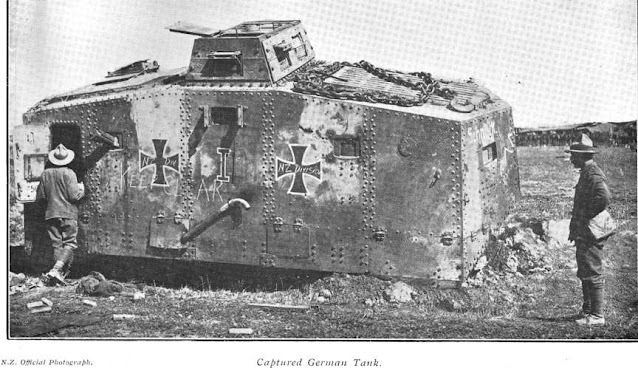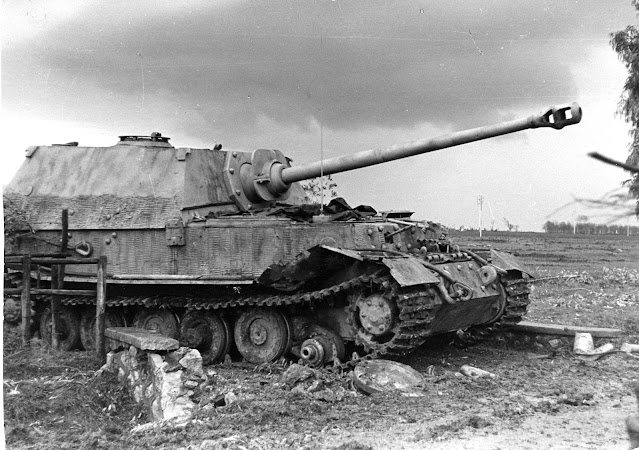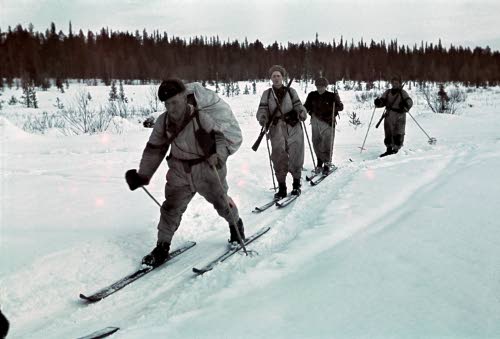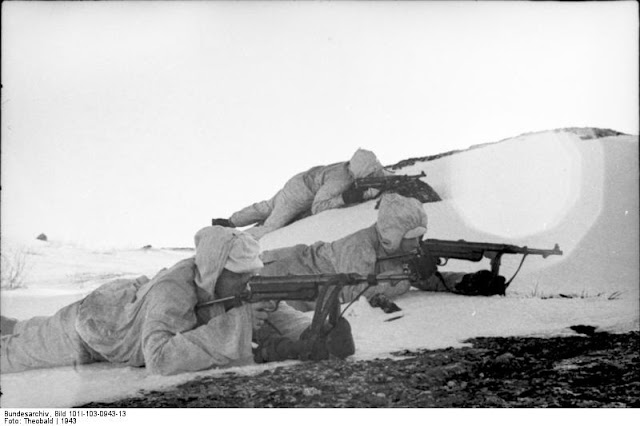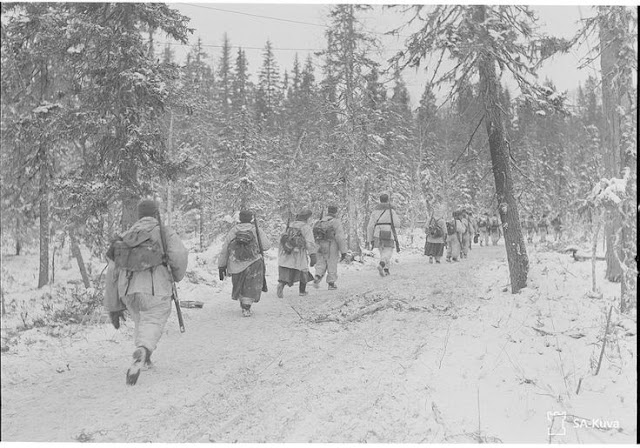Panzers In Service Of A Doomed Effort
 |
| A German Maus II, reassembled in Moscow after World War II, is being examined. It is now on display at the Kubinka tank museum. While a favorite of video game designers, only two or three were built, there is no evidence they were ever used in combat, and the only workable one was blown up by the Germans before it could be captured. I have a page about the Maus with lots of photos here. |
Here we take an overview of
German armored fighting vehicles of World War II. But first, a little history, because history greatly affected the development and use of panzers. This background is necessary to understand how and why German armored vehicles were used.
Tanks as we know them today were first introduced by the British during the Battle of the Somme in September 1916. These were used as "breakthrough" vehicles, paving the way for more vulnerable infantry. They had an immediate impact, being able to cross "no-man's land" between trenches despite the intense defensive fire and even cross over trenches with their long tracks.
The Germans were keenly aware of the effectiveness of tanks but were incapable during the war of producing their own. They only built a very small number of their own, and their most effective armored vehicles became captured British models basically with only new paint jobs.
 |
| "The first official photograph was taken of a Tank going into action, at the Battle of Flers-Courcelette, 15th September 1916. The man shown is wearing a leather tank helmet." The tank is Mark I. Note the "rudder," or steering wheel, at the back. © IWM Q 2488. |
During the interwar period, the German military had a long enforced rest during which its officers had plenty of time to study tanks and develop their own. Generals Heinz Guderian and Erwin Rommel became renowned experts in this new type of warfare and developed tactical doctrines for their use.
The Reich's tank doctrine as of 1939 was bewegungskrieg, or “War of Movement.” The British media quickly slapped the name "Blitzkrieg" (lightning war) on this during the fall of France in 1940. German tanks gained a fearsome reputation even though the basic doctrines of bewegungskrieg were not more generalized than simply rolling tanks out in front of infantry; the doctrine instead relied on close radio communication between army commanders, the Luftwaffe, and the artillery army to produce a coordinated assault of which tanks were simply one relatively small part. This all-arms approach proved devastating against Allied forces that generally had separate units for different classes of weapons with little communication between them.
To place things in perspective, during the Battle of France in April-June 1940, the composition of the German Panzerwaffe were as follows: 278 Panzer IVs, 349 Panzer IIIs, 955 Panzer IIs, 523 Panzer Is, 106 Panzer 35(t)s, and 228 Panzer 38(t)s. This was an impressive number for the time, though dwarfed by the thousands of tanks on both sides at later battles such as Kurk and the Allied breakout from Normandy.
 |
| Denmark - German Panzer II and Panzer I on parade in front of a tank commander's headquarters at Horsens on Jutland, April 1940 (Stolzenberg, Federal Archive Picture 101I-754-051N-23). |
Except for the Mark IIIs and IVs and perhaps the Czech-built Panzer 38(t)s, Germany’s panzer force wasn't that impressive in these early days. It primarily was composed of light armored fighting vehicles not much better than armored cars. Even the French-built Char BI and Char BI bis tanks were arguably comparable, though they had their own deficiencies such as poor heavy use of petrol. certainly outclassed.
However, it is a mistake to overlook the early WWI German panzers. The Wehrmacht started with no tanks, and it needed a lot. It could be more of the smaller tanks in a quicker period. The smaller tanks even had some minor advantages - they were smaller targets, they used less fuel, and they were easier to train on. But, most importantly, they were available and they worked. If World War II taught anything about weapons, it was that a working weapon that was on the scene was better than some more advanced one that was not.
The French SOMUA S35 was new, but it was quite a formidable weapon for the time. The German Mark III, arguably the backbone of the Panzerwaffe in 1940, had a smaller-caliber gun than the French tanks, and the Panzer Is and IIs were no match. The British Matilda II tank was slow but otherwise could hold its own with the German panzers. The best advantage the Wehrmacht had was in the sheer number of their armor, with the British in particular having completely inadequate numbers of armored vehicles.
Part of the German doctrine was to use the panzers as the spearhead, or schwerpunkt, against the weakest point of the opponent's line. This "point of concentration" would hopefully produce a breakthrough or rupture of the enemy’s line, to be followed immediately by faster (but lesser armored) moving motorized infantry. To ensure proper coordination, these infantry units (panzergrenadiers) typically formed an intrinsic component piece of the panzer division. The typical panzer division was composed of 2 panzer battalions and 1 motorized infantry battalion with its own self-propelled artillery for support.
That wasn't all. Panzer divisions also carried with them recovery vehicles that could retrieve disabled tanks. These specialized transporters were mobile workshops that could either repair the panzers even on the field of battle or (more likely during the early campaigns) lead them onto a train headed back to Germany.
Since communication was an irreplaceable part of German doctrine, its tanks had to have radios. It took the Allies a surprisingly long tie to appreciate the importance of equipping each panzer with its own radio set. The real advantage of the early German victories lay in this excellent communication between panzers, enabling the overall commander to more effectively direct the division to critical points on the field when they were most needed.
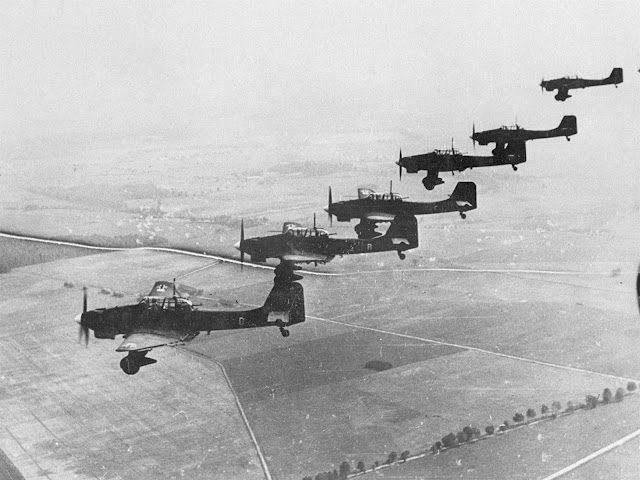 |
| Luftwaffe Junkers Ju 87 Stukas flying over Poland on a mission, 1939 (Heinrich Hoffman, Federal Archive Picture 183-1987-1210-502). |
This appreciation of the power of communication meant that the Wehrmacht was far better integrated as far as its different services went. The Luftwaffe was designed around a vision of it being an extension of the German Heer (army), able to coordinate its attacks with panzers columns. The panzer divisions would radio circling Junkers Ju-87 Stukas to identify targets blocking the advance on the ground.
Improvisation also became critical to German success during the Battle of France. French General Charles de Gaulle surprised Rommel’s 7th Panzer Division with British Matilda II and French tanks south of Arras. For a time, the German position was desperate, but then Rommel reached into his bag of tricks and unleashed the division’s attached antiaircraft company. It used its small number of 88 mm antiaircraft guns as field artillery by simply lowering the gun barrel parallel with the ground. Astonishingly, this proved devastatingly effective, and thereafter the "88s" became renowned as tank killers. They could destroy enemy tanks with a single shot on the field. This gun became so effective that it was later used as the gun mounted on the Mark VI Tiger and the King Tiger much later in the war. This eliminated the gun's major failing, that it was completely unprotected and a delicious target for Allied gunners when anywhere near the Front.
As the war progressed, the Germans doubled down on their early success with the panzer arm and continually upgraded existing tanks, and developed new models. It was this process that earned the panzers a reputation for lethality and overall quality. The development later in the war of the Mark V Panther, Mark VI Tiger, the King Tiger, and several variants of self-propelled guns and/or “tank killers” like the STUG III, Jagdpanther, and the Jagdpanzer IV were much more effective in every way than the panzers of 1939 and 1940. Unfortunately for the Germans, however, by the time these panzers entered combat, the tide of war had turned. The "Blitzkrieg" was no longer a new innovation, and the Allies had learned all of Wehrmacht's operational tricks.
The development of the Tiger tank reflected this change in circumstances. It was a heavy tank type originally designed for effecting breakthroughs in enemy lines as part of the schwerpunkt. The days of big advances, however, were over, and the Tigers had to adapt to a more defensive role for which they were never designed. In this, they were moderately successful, but their design was overkill for defending static positions. Up-gunned (75 mm) Mark IV models and even mobile artillery such as the StuG series of turretless guns were much more cost-effective, though at times (such as the rescue of trapped German forces at Cherkasy in Ukraine) the Tigers still proved indispensable.
Germany’s WWII Panzer Types & Self-Propelled Tank Killers/Assault Guns
 |
| Panzer I. |
Panzerkampfwagen I
When the Reich began re-arming in the mid-1930s, it had to start somewhere. The Panzer I was already, from a purely technical aspect, obsolete by the start of the French campaign. One of the subtle lessons of World War II, though, was that "obsolete" weapons (such as biplanes) could still be effective.
The Panzer Is were used en masse and helped to produce victory by overwhelming the Allied defenses. The Panzer Is were withdrawn from front-line formations thereafter but still used for a time as reconnaissance vehicles and on secondary fronts. The main armament: 20 mm cannon. An example is shown above.
 |
| Panzer II |
Panzerkampfwagen II
Like the Mark I panzer, the Mark II panzer was also technically obsolete by the start of the French campaign. It also was used effectively, however, and played a particularly useful and extensive role as a reconnaissance vehicle. Its chassis was used to make various self-propelled gun vehicles with various levels of success. Main armament: 20 mm cannon. An example of a Mark II is shown below.
 |
| Panzer III |
Panzerkampfwagen III
The Panzer III is one of the most underrated tanks of World War II, with its light completely outshone by later tanks. It originally was designed as Germany’s main battle tank, and it actually was quite effective in this role. It remained significant well into the Russian campaign. The panzer’s chassis was sturdy and reliable and was used for excellent armored variant types, most famously the StuG III. Its main drawback was that it could not accommodate the large guns that became necessary as the war progressed, but it still packed a punch. Main armament: Originally a 37 mm cannon later up-gunned to a 50 mm gun.
 |
| Panzer IV |
Panzerkampfwagen IV
Another pre-war tank, the Panzer IV is the first German tank to achieve legendary status. It originally was envisioned as the Mark III’s companion with a larger 75 mm short barrel firing high explosive anti-personnel ordinance designed to kill off infantry in high concentrations. In February 1941, Hitler insisted against the Heer's objections that Panzer IVs be up-gunned with more effective long barrels for the upcoming Operation Barbarossa. This extremely far-sighted decision became critically important later in the year.
The Panzer IV was the mainstay of the panzer force (panzerwaffe) throughout the war, getting the job done when possible while the flashier Tiger and Panther stole its thunder. Collectors, though, appreciate the Panzer IV and they sell for millions of dollars in good condition. Main armament: Both a short and long barrel 75 mm gun.
 |
| Panther. |
Mark V Panther
This was the first of Germany’s next-generation panzers. It was designed rapidly after the panzers ran into the Soviet T-34 and found it to be a confoundingly effective opponent. In fact, some in Germany just suggested copying the T-34 from the ground up, but German manufacturing processes would not allow that, and neither would German pride.
Officially, the Panther was described on paper as a "medium tank," but Hitler required modifications, so ultimately it weighed in at 49.4 tons - making it anything but medium. As a result of these last-minute changes and inadequate stocks of durable metals that could withstand the additional strain imposed on delicate transmission components, the Panther had continual drivetrain problems. These were never satisfactorily resolved, and they were compounded by the fact that the Panther was over-engineered. Drivers had to learn to "baby" it and not make sudden stops, starts, or turns in order to prevent another endless delay on the roadside waiting for parts.
More Panthers wound up left on the side of the road due to mechanical issues than were destroyed in combat. However, to its credit, the Panther is still acknowledged by many as the best tank of WWII. True to its origins as an antidote to the T-34, the Panther became only one of two panzer types to employ sloped armor. Main armament: 75 mm gun. I talk more about the
Panther here.
 |
| Tiger tank. |
Panzerkampfwagen VI Tiger
Without question, the Tiger tank was WWII’s most celebrated “heavy” panzer (roughly 55-60 tons). Arguably - and there are a lot of arguments on both sides for this - the Henschel-designed Panzer VI was the best tank of the war. Hitler chose Ferdinand Porsche to compete in a design competition - Henschel won, while Porsche also was awarded a contract to build 90 tanks of his losing version that became the Ferdinand/Elefant tank destroyer.
Designed at the same time as the Panther, it also developed issues because Hitler required upgrades that were never in the original design. Early variants had an underpowered engine that was prone to overheating…especially the two dozen that were sent to North Africa after the Allied Torch landings. The design incorporated overlapping and interleaved wheels that were adopted from half-tracks. While these made for a stable gun platform that could fire accurately while moving - unusual for tanks of the time - and other advantages like good off-road performance, it also caused a maintenance nightmare. The interleaving, among other things, were quite susceptible to jamming from mud and ice - and there was a lot of both of those in Russia. The design eventually reverted to just overlapping wheels, as off-road performance became less important as the war rolled west into more urban built-up areas.
Anti-magnetic "Zimmerit" paste produced by Zimmer & Co. in Berlin was applied, giving a distinctive rough appearance, but eventually abandoned late in the war because it required an additional day to apply and the Reich simply didn't have the time. Most teething issues were ironed out relatively quickly after the Tiger I first entered service in August 1942.
The Tiger's biggest problem was that there weren’t enough of them to stem the Soviet tide that began pushing west after 1942. Only 1,347 or so units were produced during the war compared to 35,120 Soviet T-34s and 48,950 T-34-85s. The Tigers were good, but they weren't good enough to overcome odds like that. Main armament: 88 mm gun. I talk a lot more about the Tiger with
plenty of photos here.
 |
| King Tiger aka Tiger II. |
Panzerkampfwagen Tiger Ausf. B King Tiger
Developed in 1943, this heavy beast (up to 75.5 tons) incorporated all the things learned about armored warfare previously to make a true state-of-the-art tank. More than any other tank, the King Tiger was the culmination of German armored vehicles, incorporating lessons learned from the Tiger I (no interleaved wheels) and the Panther (sloped armor). One of the reasons the Tiger II was so good was that it was not a rushed wartime weapon - design and testing actually began in the late 1930s to fill the hole in the panzer lineup for a heavier tank than the Panzer IV. It usually came in around 69.5 tons, but with fewer design compromises than the Tiger even though it weighed only about 15% more.
This was Germany’s only panzer besides the Panther to incorporate sloped armor. The Soviet T-34 basically introduced sloped armor, and the T-34's success resulted in it gaining an outsized reputation, but sloped armor imposed various tradeoffs (such as space available within the tank) that were not all beneficial. The initial production of 40 King Tigers had an underpowered engine which was upgraded to a more powerful engine (V-12 Maybach HL 230 P30 gasoline - all panzers ran on gasoline, btw) for the remaining production run. Many still felt it was underpowered, but based on all the testing done it was more than sufficient for what it had to do. King Tigers did not have to be fast, they just had to get to where they were going.
This panzer incorporated some of the first electronically assisted gun sights like the Panther tank. The King Tiger really didn’t have long enough service life - only about 489 were built - to iron out the usual teething issues associated with new tanks. It replaced the Tiger I in the production lines and was a worthy successor. Armament: 88 mm (8.8 cm KwK 43). I talk more about the King Tiger here.
Ferdinand/Elefant Tank Destroyer
When the Wehrmacht finally realized what it was up against in the Soviet Union, it quickly organized a competition to design a heavy tank. The main competitors were Henschel, which had a lot of experience building tanks, and Porsche, which had virtually no such experience. Unsurprisingly, Henschel provided the more efficient vehicle - the Tiger - while Porsche came up with a design that was less like a tank and more like an artillery piece. It also was extremely heavy at about 70 tons, which made it slow and unwieldy. While inferior in the intended role of a breakthrough armored vehicle, the Porsche design still was fearsome and usable. Thus, the Wehrmacht decided on an "all of the above" strategy and ordered about 90 of them.
The Ferdinands, as they were called after the name of the Porsche CEO (and Hitler crony), were rushed into service at Kursk in July 1943 and actually did fairly well. However, they received a bad reputation that was exaggerated by post-war writers due to a lack of secondary armament (machine guns) that Porsche, being inexperienced in this field, did not realize were important. So, stories surfaced of Soviet soldiers creeping up on them and pouring gasoline in their engine vents to set them on fire and so forth.
The main point in their favor, though, was that they mounted Krupp's newly developed 88 mm (3.5 in) Panzerjägerkanone 43/2 (PaK 43). This made them more effective as artillery pieces advancing behind the front rather than, as at Kursk, being used at the tip of the schwerpunkt. Once used properly, they came into their own and acquired a fearsome reputation as a defensive weapon with a probably exaggerated kill ratio better than just about any other Wehrmacht armored vehicle.
While Porsche's lack of experience with tanks was obvious and had baleful consequences, its experience making cars for decades provided some subtle advantages in the engine and suspension areas. The Ferdinands continued providing support fire for retreating Wehrmacht troops, proving much more effective in this role, until being recalled to Germany early in 1944 for modifications (such as the installation of MG-34 machine guns for defensive purposes). They then were sent south to Italy, where they remained in service for as long as they lasted. Because of their distinctive appearance, the troops started calling them "Elefant," and eventually, on 1 May 1944, this became their semi-official name (they actually were the Panzerjäger Tiger (P), but nobody called them that).
The Elefant is the most maligned German armored vehicle, but wrongly so. Despite being prone to mechanical breakdowns as with the Panther - a common situation for World War II tanks on both sides, particularly Soviet ones - the idea that they were ineffective and extremely vulnerable is simply false. While they were all built in early 1943, a company of them lasted until the very end of the war. They saw action on the Oder Front and, finally, defending the Zossen Wehrmacht headquarters (sort of the German Pentagon) south of Berlin in late April 1945. I talk a lot more about the Elefant with photos here.

Sturmgeschütz III (StuG III)
Even though they looked similar, the Sturmgeschütz III assault gun series was developed on a completely separate track from the panzers. Rather than being designed as a "breakthrough" weapon like panzers, the StuG was intended to fulfill the need for mobile artillery that could keep up with the troops. During the German spring 1918 offensives that are now largely forgotten, one of the main drawbacks was that the infantry outran its artillery support, which had difficulty crossing over captured trenches and other rough battle-scarred terrains.
The advantage of the StuG was not that it was superior to panzers because it had a fixed gun and other drawbacks. Instead, it was that it was cheap and plentiful and could accomplish 80% of what a comparable panzer could at maybe half the cost. They were with the common infantry, providing help on a daily basis, whereas panzers were usually kept in separate units often under the control of the highest authority (Hitler himself often directed Tiger and Panther employment instead of local commanders). Here we get into the issue of the theory that hindered use, as Germans recalled their WWI experience and viewed panzers inherently as forming the spear of the schwerpunkt - which, admittedly, they were designed for and very good at - whereas artillery pieces like the StuG, though quite similar, were viewed differently and thus could be allowed to be used just any old way. In a way, because they were less notorious and revered, StuGs thus were allowed to be more effective in their natural infantry-support role than the panzers could be in theirs.
Being cheap and cost-effective, the StuGs were Germany's most-produced (over 13,500 units made) tracked armored fighting vehicle. As an example of their efficiency, eventually, they were built simply using the already proven Mark III chassis rather than being designed from the ground up, which would have required time and expense that simply wasn't available. There were multiple variants from Ausf. A through G as the Wehrmacht refined the design into an efficient killing machine, but the final design was pretty much set by 1942.
Not having a turret, while otherwise a "drawback," actually had some advantages other than cost. One of these was that the StuG could carry a larger gun than a comparable Panzer III. It was a highly versatile vehicle armed originally with a short 75 mm gun barrel designed for the high explosive anti-personnel ordinance. Later variants used the long barrel 75 mm gun (7.5 cm StuK 40 L/48) that was used in the up-gunned Panzer IV from 1941 on. The assault gun’s low profile made it harder to target than other panzer types in the field, again endearing it to its crews.
The German tank experts were not stupid - they appreciated the value of the StuG. When Hitler, rocked by the defeat at Stalingrad, brought renowned panzer expert Heinz Guderian back as Inspector General of Armored Troops, on 1 March 1943, he demanded and acquired control of the panzer arm - but was stunned and saddened to learn that, in his appointment order, the StuG series had been reclassified as artillery and thus was out of his control. His control over events thus was dramatically reduced even though at face value he had received a significant role.
Main Armament: long/short 75 mm gun barrel.
 |
| Sturmtiger. |
Sturmtiger Assault Tiger
There weren't very many Sturmtigers built, but those that entered the battle made a big impression. Officially designated the Sturmmörserwagen 606/4 mit 38 cm RW 61, they were based on the late models of the Tiger I, with the same Maybach HL230 P45 V-12, water-cooled gasoline engine, hull, suspension, and many other aspects. It had sloped (at 47° from vertical) frontal armor (note: this was not a tank, but an assault gun) and additional plating that pushed its weight up to 68 tons.
The most noticeable aspect of the Sturmtiger was the 380 mm RW 61 rocket launcher L/5.4 main weapon, with an additional 100 mm grenade launcher thrown in for kicks. The barrel is big enough for someone to crawl inside it, something Allied soldiers who came across one after the war liked to do. Various shells were used, with one being 376 kg (829 lb), with a maximum range of up to 6,000 m (20,000 ft). So, the Germans could park one of these four or five miles from the target and pound away.
The genesis of the weapon was a need for a mobile gun that could destroy buildings, which was needed in Stalingrad. Only about 18 were completed, with the first delivered in August 1944. At least one immediately went into action to quell the Warsaw Uprising of September 1944, and it was effective in leveling the city. As with other massive German artillery pieces, the Sturmtiger could not carry much ammunition, with space for only 14 of the massive shells. They were so heavy that a loading crane at the back of the vehicle was standard equipment. There is a Sturmtiger on display at the Deutsches Panzermuseum. I talk more about the
Sturmtiger here.
 |
| A Hummel in the Soviet Union January/February 1944. Note the open tailgate (Wehmeyer, Federal Archive Picture 101I-278-0898-04). |
Hummel Self-Propelled Gun
The Hummel was sort of an advanced StuG. It was designed later and, like the StuG, used available parts to save time and design expense. In this case, it used a "Frankensteined" combination of the available chassis parts of the Panzer III (driving and steering systems) and Panzer IV (suspension and engine). The main difference from the StuG was that it mounted a much larger gun, the massive 15 cm sFH 18/1 L/30. Ironically, the main drawback of the Hummel was that the gun was too big and thus the vehicle was not able to carry enough of the large shells required for combat. So, a completely separate complementary vehicle without the main gun, the Munitionsträger Hummel (literally, ammunition-carrying Hummel), was built to accompany them.
The Hummel was effective, and 700 were built along with 150 of their ammunition-carrying sidekicks. Hitler eventually decided they needed a more serious and warlike name - Hummel means "bumblebee" - and so on 27 February 1944 ordered that they be referred to by the far less catchy official name of Panzerfeldhaubitze 18M auf Geschützwagen III/IV (Sf) Hummel, Sd.Kfz. 165 - minus the "Hummel" part. Speed: 42 km/h (26 mph) - roughly the same as the StuG III.
Jagdpanther Sd.Kfz. 173
The Jagdpanther was probably Germany’s best tank killer of the war. Unfortunately, this vehicle’s high price limited its overall success with only 415 units produced. Like the StuG series, its design made use of another proven platform, being built on the Panther’s chassis. This also meant that it inherited the Panther's issues, being excessively overengineered and having various mechanical issues. The Panther proved more difficult to convert into an assault gun/tank killer compared with the STUG III/Mark III conversion. However, its sleek design made it quite survivable for its crew. Main Armament: 75 mm gun.
Conclusion
As shown above, the Wehrmacht designed a variety of armored vehicles to fill a variety of niches. The panzer series was designed as a breakthrough weapon, whereas the StuG, Hummel, Elefant, and Jagdpanther were more artillery pieces. The Wehrmacht also had some vague plans for
gigantic fantasy tanks that would have had guns of the same caliber as on battleships, but these never got beyond the talking stage.
In addition, there also were some even heavier pieces such as the Karl Gerät 1 "Thor," but here we begin moving too closely to pure artillery pieces with minimal mobility. The most versatile of them all was the StuG II, which could be used in both roles, and that is likely why more of them were built than any other German armored vehicle.
Overall, it was an impressive group of vehicles. However, the German economy had difficulty producing them all in sufficient quantities. In military parlance, there was too much "dispersion of effort." Germany likely would have been better served by focusing on fewer types of armored vehicles and producing more of the most efficient types.












.jpg)










